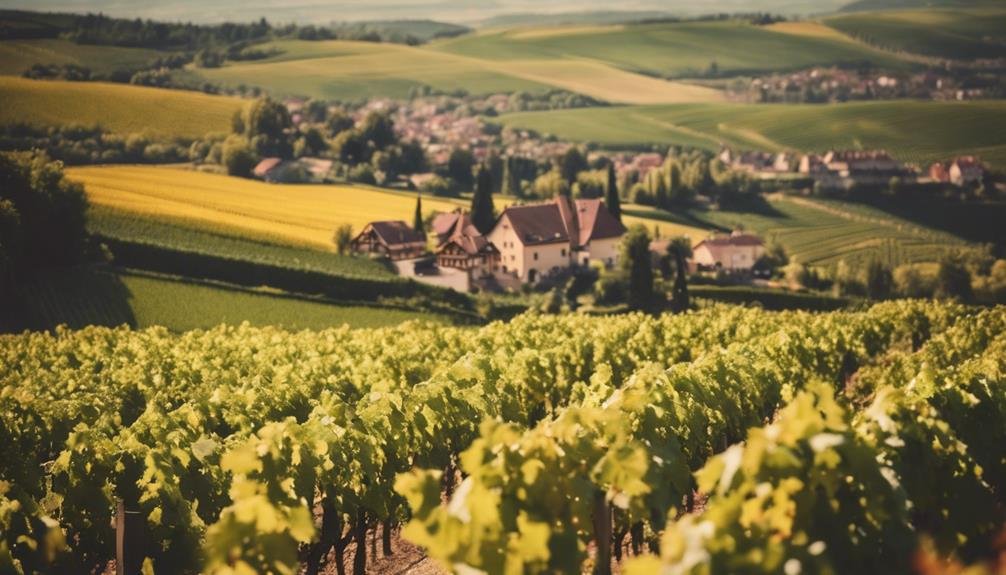Explore Alsace's wine paradise, showcasing exceptional varieties like Riesling, Gewürztraminer, and Pinot Gris. These aromatic wines offer citrus, lychee, and pear notes, creating a rich, elegant experience. The unique bottle shape, Flûte d'Alsace, adds to the aesthetic appeal. Classified based on varietals, Alsace wines range from $12 to $20, emphasizing popular grapes. The region's diverse terroir, shielded by Vosges Mountains, influences flavors unique to each subregion like Bas-Rhin and Haut-Rhin. Discovering Alsace reveals a world of wine-making traditions and terroir complexity, ideal for wine lovers seeking a tantalizing journey into French wine culture.
Alsace Wine Overview
In the world of fine wines, Alsace stands out for its exceptional grape varieties, including Riesling, Gewürztraminer, and Pinot Gris, known for their age-worthiness and easy quality identification.
Alsace wine production focuses on these noble grapes, resulting in aromatic, elegant wines with distinct characteristics. Riesling offers notes of citrus and mineral, Gewürztraminer boasts exotic lychee and rose aromas, while Pinot Gris delivers a rich, full-bodied experience with hints of pear and spice.
When tasting Alsace wines, expect vibrant acidity, complex flavors, and a lingering finish that pairs excellently with a variety of dishes. To enhance the experience, serve Alsace wines slightly chilled at around 50-54°F to fully appreciate their nuanced profiles and exceptional quality.
Alsace Wine Classifications
Classifying Alsace wines involves distinct criteria that highlight their quality and origin. Alsace wines are categorized based on the varietal labeling system, where the grape variety is prominently displayed on the bottle.
Additionally, Alsace wines are known for their unique bottle shape called Flûte d'Alsace, which sets them apart aesthetically. This bottle shape, tall and slender, is a trademark of Alsace wines and is designed to showcase the wines' elegance and purity.
The Alsace AOP wines, with a focus on popular grape varieties such as Riesling, Gewürztraminer, and Pinot Gris, range in price from $12 to $20. Understanding these classifications can help wine enthusiasts navigate the diverse and flavorful world of Alsace wines with confidence.
Alsace Wine Regions

Moving from understanding the classifications of Alsace wines, exploring the diverse and distinct Alsace wine regions provides a deeper insight into the terroir and characteristics shaping these renowned French wines.
Alsace vineyards offer a unique blend of geography, climate, and soil types, contributing to the exceptional quality and variety found in the region's wines. The terroir exploration in Alsace reveals how the Vosges Mountains shield vineyards from rain, creating a dry microclimate ideal for grape cultivation.
Each subregion within Alsace, such as the Bas-Rhin and Haut-Rhin, showcases specific terroir influences that define the flavors and aromas of wines produced there. By delving into Alsace's various wine regions, wine enthusiasts can truly appreciate the complexity and richness that the region has to offer.
Frequently Asked Questions
What Food Pairings Work Best With Alsace Wines?
When contemplating food pairings for Alsace wines, it is crucial to highlight their diverse flavor profiles that complement various culinary traditions. With regional influence and global appeal, these wines harmonize with both classic dishes and innovative cuisine, enhancing dining experiences.
Are There Any Unique Winemaking Techniques Used in Alsace?
In Alsace winemaking, a blend of traditional and modern techniques is employed. Sustainability practices, including biodynamic farming techniques, are common. Some producers opt for indigenous yeast fermentation, enhancing the region's reputation for quality wines with a unique character.
How Do Alsace Wines Compare to Other French Wines?
Alsace wines offer a distinct character compared to Bordeaux and Burgundy. With aromatic whites like Riesling and Gewürztraminer, Alsace showcases unique varietals, vibrant acidity, and terroir-driven flavors. This region's wines stand out for their precision and elegance.
What Makes Alsace Grand Cru Wines so Special and Distinct?
Alsace Grand Cru wines stand out for their unique terroir, featuring diverse soil compositions that impart distinctive flavors. Aging in ideal conditions enhances complexity, allowing noble grape varieties to flourish. This meticulous process creates high-end wines of exceptional quality and distinction.
Are There Any Upcoming Trends in Alsace Wine Production?
In Alsace wine production, emerging trends include a shift towards sustainable practices like biodynamic farming. Additionally, there is a growing interest in natural and orange wines, reflecting a broader movement towards organic viticulture and minimal intervention winemaking methods.
Conclusion
To wrap up, Alsace wines offer a mesmerizing journey through centuries of winemaking tradition and exquisite grape varietals. Like a masterfully crafted symphony, each sip of Alsace wine tells a story of elegance and refinement, inviting wine lovers to immerse themselves in the region's rich viticultural heritage.
With its unique terroir, age-worthy qualities, and diverse classifications, Alsace truly is a wine lover's paradise waiting to be discovered.